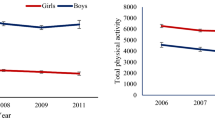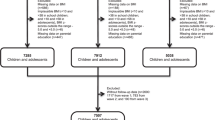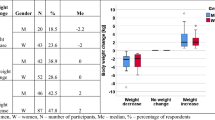Abstract
Background/Objectives:
The United Arab Emirates has undergone remarkable economic and social transformations over the past few decades. We present findings on the prevalence of overweight and obesity, dietary and activity patterns among Emiratis in 2009/10, and explore associated urbanization and wealth factors.
Subjects/Methods:
A cross-sectional study was conducted in 628 randomly selected households in all seven emirates. Sociodemographics, 24-h dietary recalls, physical activity and anthropometric data were collected from adult females (⩾19 years), adolescents (11–18 years) and children (6–10 years) in each family via in-person interviews using validated questionnaires.
Results:
In 2009/10, 65% of adult women, 28% of male adolescents and 40% of female adolescents, 25% of male children and 41% of female children were overweight or obese. 43% of girls and 38% of boys (6–10 years) consumed more calories than their estimated energy requirements. Snacking represents a major source of Emirati caloric intake (>20%) of total calories. In addition, caloric beverages account for 8–14% of total calories. Meanwhile, physical activity levels are low, especially among females Emiratis and those living in urban areas.
Conclusions:
These trends represent the potential risk for severe cardiometabolic problems in the United Arab Emirates. The significant gender differentials among children and adolescents are driven by diet and activity differences. More attention should be paid to educate the public on nutrition (for example, limit the consumption of sugared sodas, fruit drinks and whole milk, promote water and low-fat/skim milk consumption instead) and encourage physical activity from a young age, especially among females. Built environments and social support for improved lifestyle choices by individuals are needed.
This is a preview of subscription content, access via your institution
Access options
Subscribe to this journal
Receive 12 print issues and online access
$259.00 per year
only $21.58 per issue
Buy this article
- Purchase on Springer Link
- Instant access to full article PDF
Prices may be subject to local taxes which are calculated during checkout




Similar content being viewed by others
References
Al-Amiri HA, Al-Hamad NM, Al-Awadhi FS, Al-Foudari MY, Al-Otaibi JA, Heji AHB (2011). Total, insoluble and soluble dietary fiber contents of selected Kuwaiti composite dishes. Int J Food Sci Nutr 62, 152–157.
Al-Amiri HA, Al-Otaibi JA, Al-Foudari MY, Heji AHB (2009). The nutritive value of selected commonly consumed Kuwaiti dishes. Int J Food Sci Nutr 60, 668–676.
Al-Hazzaa HM (2007). Health-enhancing physical activity among Saudi adults using the International Physical Activity Questionnaire (IPAQ). Public Health Nutr 10, 59–64.
Al-Hourani HM, Henry CJ, Lightowler HJ (2003). Prevalence of overweight among adolescent females in the United Arab Emirates. Am J Hum Biol 15, 758–764.
Al-Isa AN, Moussa MA (1999). Factors associated with overweight and obesity among Kuwaiti kindergarten children aged 3–5 years. Nutr Health 13, 125–139.
Al-Kandari YY (2006). Prevalence of obesity in Kuwait and its relation to sociocultural variables. Obes Rev 7, 147–154.
Al Frayh AR, Shakoor Z, Gad El Rab MO, Hasnain SM (2001). Increased prevalence of asthma in Saudi Arabia. Ann Allergy Asthma Immunol 86, 292–296.
Ali HI, Bernsen RM, Baynouna LM (2008). Barriers to weight management among Emirati women: a qualitative investigation of health professionals’ perspectives. Int Q Comm Health Educ 29, 143–159.
Amine EK, Samy M (1996). Obesity among female university students in the United Arab Emirates. J R Soc Health 116, 91–96.
Barquera S, Hernández L, Tolentino ML, Espinosa J, Leroy J, Rivera J et al. (2008). Energy from beverages is on the rise among Mexican adolescents and adults. J Nutr 138, 2454–2461.
Berger G, Peerson A (2009). Giving young Emirati women a voice: participatory action research on physical activity. Health Place 15, 117–124.
Booth M (2000). Assessment of physical activity: an international perspective. Res Q Exerc Sport 71, S114–S120.
Carter AO, Elzubeir M, Abdulrazzaq YM, Revel AD, Townsend A (2003). Health and lifestyle needs assessment of medical students in the United Arab Emirates. Med Teach 25, 492–496.
Cole TJ, Bellizzi MC, Flegal KM, Dietz WH (2000). Establishing a standard definition for child overweight and obesity worldwide: international survey. Br Med J 320, 1240–1243.
Craig CL, Marshall AL, Sjorstrom M (2003). International physical activity questionnaire: 12-country reliability and validity. Med Sci Sports Exerc 35, 1381–1395.
Dashti B, Al-Awadi F, Khalafawi MS, Sawaya W, Al-Amiri H (2003). Soluble and insoluble dietary fibre in thirty-two Kuwaiti dishes. Food Chem 83, 557–561.
Dashti B, Al-Awadi F, AlKandari R, Ali A, Al-Otaibi J (2004). Macro- and microelements contents of 32 Kuwaiti composite dishes. Food Chem 85, 331–337.
Dashti BH, Al-Awadi F, Khalafawi MS, Al-Zenki S, Sawaya W (2001). Nutrient contents of some traditional Kuwaiti dishes: proximate composition, and phytate content. Food Chem 74, 169–175.
Dietz WH (1996). The role of lifestyle in health: the epidemiology and consequences of inactivity. Proc Nutr Soc 55, 829–840.
ESHA Research (2006). Food Processor and Genesis SQL Database Sources. Salem: OR.
Flegal KM, Carroll MD, Ogden CL, Curtin LR (2010). Prevalence and trends in obesity among US adults, 1999–2008. JAMA 303, 235–241.
Hagströmer M, Oja P, Sjöström M (2006). The International Physical Activity Questionnaire (IPAQ): a study of concurrent and construct validity. Public Health Nutr 9, 755–762.
Hallal PC, Victora CG (2004). Reliability and Validity of the International Physical Activity Questionnaire (IPAQ). Med Sci Sports Exerc 36, 556.
Ibrahim AJ, Abdulbari B, Andrew B (2006). Prevalence of asthma among Qatari schoolchildren: International Study Of Asthma and Allergies In Childhood, Qatar. Pediatr Pulmonol 41, 80–86.
Institute of Medicine (2002). Dietary Reference Intakes for Energy, Carbohydrates, Fiber, Fat, Protein and Amino Acids (Macronutrients). IOM: Washington DC.
International Monetary Fund (2009) World Economic Outlook Database, April 2009: nominal GDP list of countries. Data for the year 2008.
IPAQ Research Committee (2005). Guidelines for Data Processing and Analysis of the International Physical Activity Questionnaire (IPAQ).
Kerkadi A (2003). Evaluation of nutritional status of United Arab Emirates University female students. Emir J Agric Sci 15, 42–50.
Kerkadi A, Abo-Elnaga N, Ibrahim W (2005). Prevalence of overweight and associated risk factors among primary female school children in Al-Ain City, UAE. Emir J Agric Sci 17, 43–56.
Kruger J, Kohl HW, Miles IJ (2007). Prevalence of regular physical activity among adults - United States, 2001 and 2005. MMWR 56, 1209–1212.
Kuwait Institute for Scientific Research (1998). Food Composition Tables for Kuwait Composite Dishes. Kuwait Institute for Scientific Research: Kuwait.
Mabry RM, Reeves MM, Eakin EG, Owen N (2010). Evidence of physical activity participation among men and women in the countries of the Gulf Cooperation Council: a review. Obes Rev 11, 457–464.
Malik M, Bakir A (2007). Prevalence of overweight and obesity among children in the United Arab Emirates. Obes Rev 8, 15–20.
Moshfegh AJ, Rhodes DG, Baer DJ, Murayi T, Clemens JC, Rumpler WV et al. (2008). The US Department of Agriculture Automated Multiple-Pass Method reduces bias in the collection of energy intakes. Am J Clin Nutr 88, 324–332.
Musaiger AO, Radwan HM (1995). Social and dietary factors associated with obesity in university female students in United Arab Emirates. J R Soc Health 115, 96–99.
Musaiger AO, Abuirmeileh NM (1998). Food consumption patterns of adults in the United Arab Emirates. J R Soc Health 118, 146–150.
Musaiger AO, Arab Taskforce for O, Physical Activity. Kingdom of B (2003a). Recommendations of the First Conference on Obesity and Physical Activity in the Arab countries. Held in Bahrain, 24-26 September, 2002. Nutr Health 17, 117–121.
Musaiger AO, Lloyd OL, Al-Neyadi SM, Bener AB (2003b). Lifestyle factors associated with obesity among male university students in the United Arab Emirates. Nutr Food Sci 33, 145–147.
Ng SW, Zaghloul S, Ali HI, Harrison G, Popkin BM (2011). The prevalence and trends of overweight, obesity and nutrition-related non-communicable diseases in the Arabian Gulf States. Obes Rev 12, 1–13.
Ogden CL, Carroll MD, Curtin LR, Lamb MM, Flegal KM (2010). Prevalence of high body mass index in US children and adolescents, 2007–2008. JAMA 303, 242–249.
Piernas C, Popkin BM (2010a). Trends in snacking among US children. Health Affairs 29, 398–404.
Piernas C, Popkin BM (2010b). Snacking increased among US adults between 1977 and 2006. J Nutr 140, 325–332.
Popkin BM (2010). Patterns of beverage use across the lifecycle. Physiol Behav 100, 4–9.
Popkin BM, Ng S, Mhurchu CN, Jebb S (2010). Beverage Patterns and Trends in the United Kingdom. University of North Carolina: Chapel Hill.
Qahoush R, Stotts N, Alawneh MS, Froelicher ES (2010). Physical activity in Arab women in Southern California. Eur J Cardiovascular Nursing 9, 263–271.
Rabbia A, El-Moneim HQ, Al-Majeed TQ, Alami H (2004). Assessing health risk behaviours among secondary school students in Abu Dhabi. Abu Dhabi, UAE.
Raper N, Perloff B, Ingwersen L, Steinfeldt L, Anand J (2004). An overview of USDA's dietary intake data system. J Food Composition Analysis 17, 545–555.
Sheikh-Ismail LI, Henry CJ, Lightowler HJ, Aldhaheri AS, Masuadi E, Al Hourani HM (2009). Prevalence of overweight and obesity among adult females in the United Arab Emirates. Int J Food Sci Nutr 60, 26–33.
StataCorp (2009). Stata Statistical Software: Release 11. StataCorp LP: College Station, TX.
UAE-GSHS (2005) In: Al-Matroushi MA, Fikry M (eds). United Arab Emirates Global School-based Student Health Survey. UAE-GSHS: UAE.
UAEHALS (2000). Measuring the Health of the Nation: United Arab Emirates Health and Lifestyle Survery. In: Badrinath P, Al-Shboul QA, Zoubeidi T, Gargoun AS, Ghubash R, El-Rufaie OE (eds). Al-Ain, UAE, United Arab Emirates University.
Vyas S, Kumaranayake L (2006). Constructing socio-economic status indices: how to use principal components analysis. Health Policy Plan 21, 459–468.
Wasfi AS, El-Sherbiny AA, Gurashi E, Al Sayegh FU (2008). Sport practice among private secondary-school students in Dubai in 2004. East Mediterr Health J 14, 704–714.
WHO. World Health Survey. WHO: Geneva.
WHO (2000). Obesity: Preventing and Managing the Global Epidemic: Report of a WHO Consultation. World Health Organization: Geneva.
Yeatts K, Sadig M, Olshan A, Leith D, Funk W, Masakiri F (2011). Evaluation of potential association of indoor air quality with asthma, respiratory symptoms, allergic rhinitis, and eczema. UAE-IAHN. University of North Carolina, Chapel Hill, NC. (working papers).
Zaghloul S, Waslien A, Al Somaie M, Parakash P . Low adherence of Kuwaiti adults to fruit and vegetable guidelines. East Mediterr Health J (in press).
Zaghloul S, Ilyan I, Al-Hamly S, Al-Attar H, Al-Amiri H, Dashti B et al. (2010). Kuwait Food Instruction Booklet. Kuwait Institute for Scientific Research: Kuwait City.
Acknowledgements
This work is supported by the United Arab Emirates Environmental Agency, Abu Dhabi. We thank the University of North Carolina's Collaborative Studies Coordinating Center, the interviewers, nurses, dietitians, data coders and respondents in the United Arab Emirates who were involved in the UNC-Indoor Air, Health and Nutrition Study. In addition, thanks to Phil Bardsley for programming assistance, Frances Dancy for administration help and Tom Swasey for graphics assistance.
Author information
Authors and Affiliations
Corresponding author
Ethics declarations
Competing interests
The authors declare no conflict of interest.
Rights and permissions
About this article
Cite this article
Ng, S., Zaghloul, S., Ali, H. et al. Nutrition transition in the United Arab Emirates. Eur J Clin Nutr 65, 1328–1337 (2011). https://doi.org/10.1038/ejcn.2011.135
Received:
Revised:
Accepted:
Published:
Issue Date:
DOI: https://doi.org/10.1038/ejcn.2011.135
Keywords
This article is cited by
-
Dietary patterns and their associations with postpartum weight retention: results of the MINA cohort study
European Journal of Nutrition (2024)
-
Adherence to the Mediterranean diet and its association with environmental footprints among women of childbearing age in the United Arab Emirates
European Journal of Nutrition (2022)
-
Perceived social support and self-efficacy beliefs for healthy eating and physical activity among Arabic-speaking university students: adaptation and implementation of health beliefs survey questionnaire
BMC Public Health (2021)
-
Practices and resilience of dieticians during the COVID-19 pandemic: a national survey in the United Arab Emirates
Human Resources for Health (2021)



